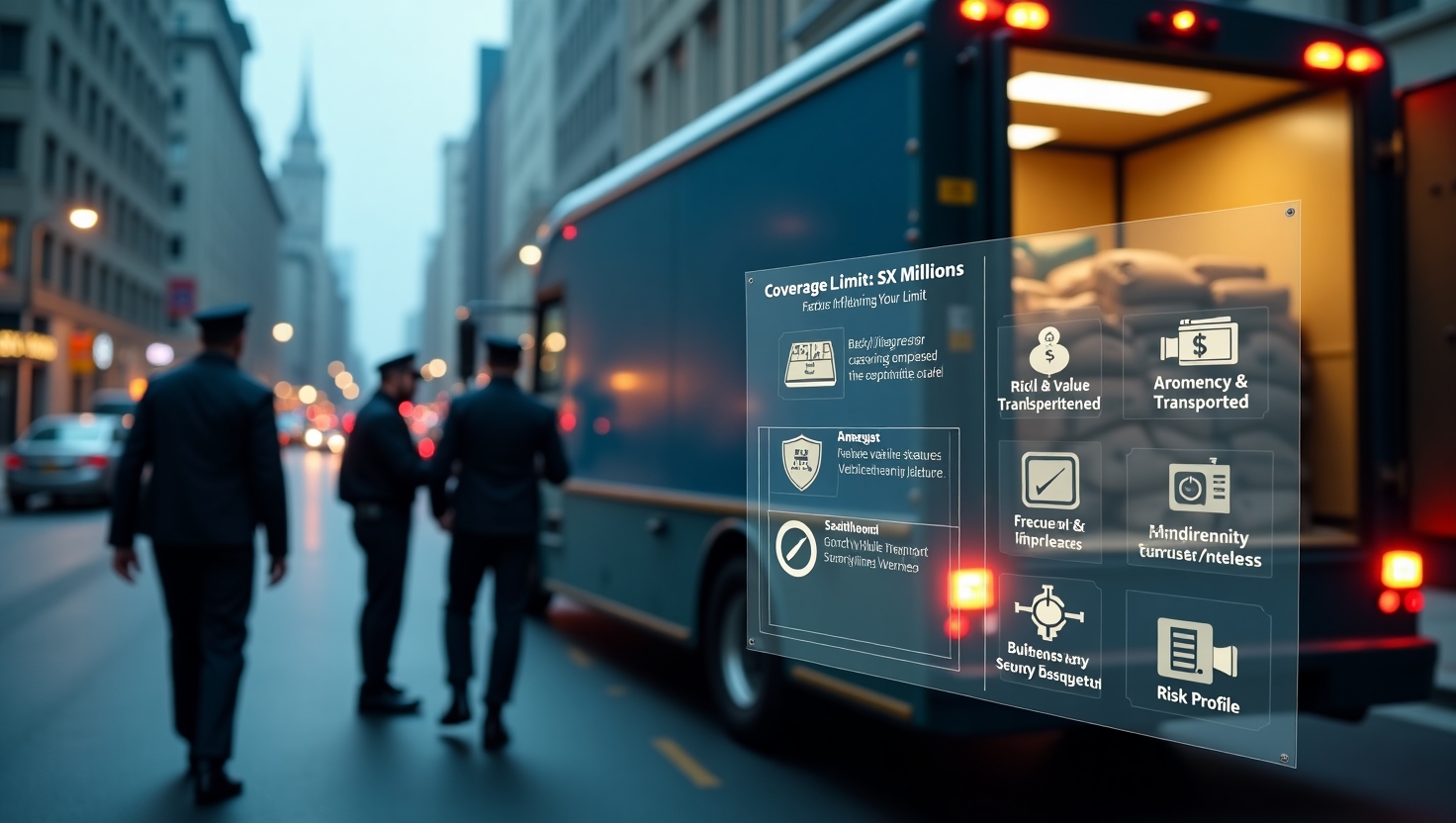In today’s fast-paced world, keeping cash and valuables safe is key. Whether you run a store, a bank, or handle logistics, losing money in transit can hurt your business a lot. But, there’s a way to lower these risks and keep your assets safe. That’s where cash in transit insurance comes in – a vital shield for your business’s moving money.
Ever wondered, what is cash in transit insurance and how does it help your business? This article dives deep into this crucial coverage. We’ll cover its importance, the risks it guards against, the policies you can get, and how to pick the best one. By the end, you’ll know how to protect your business’s money, no matter where it goes.

Table of Contents
ToggleKey Takeaways
- Cash in transit insurance covers the safe move of cash and valuables, shielding your business from theft, loss, or damage risks.
- Knowing the importance of protecting your funds and the specific dangers of moving money is key to figuring out your coverage needs.
- Learning about the various cash in transit insurance policies and options will help you find the perfect match for your business.
- Choosing the right insurance provider based on coverage limits, premiums, and security practices is crucial for your cash transportation needs.
- Following best practices for cash transport security can also help reduce risks and support your insurance coverage.
What is Cash in Transit Insurance?
Cash in transit insurance is a special kind of coverage for businesses that move a lot of cash. It protects against theft, robbery, and other unexpected events. This insurance is crucial for keeping your money safe while it’s being moved.
Understanding the Importance of Safeguarding Your Funds
Businesses with lots of cash, like retailers and banks, face big challenges. Moving cash is risky because it attracts thieves. That’s why cash in transit insurance is key to keeping your money safe and your business running smoothly.
Risks Involved in Cash Transportation
Transporting cash comes with big risks for businesses. These risks can hurt your finances and operations. Some common risks include:
- Theft and robbery: Criminals often target cash-in-transit vehicles, putting employees and funds at risk.
- Accidental loss or damage: Cash can get lost or damaged during transit due to accidents or natural disasters.
- Employee dishonesty: Even trusted employees might steal money, causing financial loss.
- Regulatory compliance issues: Businesses must follow strict rules when moving cash. Breaking these rules can lead to fines.
Cash in transit insurance acts as a safety net for businesses. It helps them bounce back from these risks without major financial loss.
Types Of Cash in Transit Insurance
Protecting your business’s money when it’s moved is crucial. Cash in transit insurance is key for this. It guards against risks like theft and damage when moving cash and valuables. Knowing what coverage and options are out there helps you choose the right insurance for your business.
Types of Coverage and Policy Options
Cash in transit insurance covers several risks:
- Theft or robbery during transit
- Accidental loss or damage to the cash or valuables
- Destruction or disappearance of the cash or valuables
- Employee dishonesty or infidelity
The amount of coverage and deductibles can change based on the policy. You might also add extra protections, like emergency funds or liability coverage. Always read the policy carefully to know what’s included in your cash in transit insurance policy.
| Coverage Type | Description | Typical Limits |
|---|---|---|
| Theft or Robbery | Protection against the loss of cash, checks, or other valuables due to theft or robbery during transit | $50,000 - $1,000,000 |
| Accidental Loss or Damage | Coverage for cash, checks, or other valuables that are accidentally lost or damaged during transportation | $25,000 - $500,000 |
| Employee Dishonesty | Protection against the loss of cash, checks, or other valuables due to the dishonest acts of your employees | $25,000 - $250,000 |
By knowing the different coverages and options, you can customize your cash in transit insurance policy to fit your business’s needs.
Assessing Your Cash Transportation Needs
When it comes to cash in transit insurance, finding the right coverage is key. You need to look at your specific needs carefully. This includes many factors that affect the risks and security you need.
First, think about how much cash your business moves. The more cash, the more insurance you need. Also, consider how often you transport cash. If it’s often, you might need stronger protection.
- Look at the routes your cash takes. Some areas might be riskier than others.
- Check your current security steps. Things like armored cars and guards can change what insurance you need.
By examining these points, you can get the right cash in transit insurance for your business. This way, you protect your money and avoid big losses if something goes wrong.
“Proper assessment of cash transportation needs is the foundation for securing the right cash in transit insurance coverage.”
It’s important to find cash in transit insurance that matches your business. This lets you relax and focus on what you do best.
Choosing the Right Cash in Transit Insurance Provider
Finding the best cash in transit insurance provider is key to protecting your business. Look for a provider that fits your specific needs. There are important factors to consider when choosing.
Key Factors to Consider
- Financial stability of the insurance provider: Choose a company with a solid financial rating and a history of paying claims.
- Claims history and customer service: Check how well the provider handles claims and customer issues.
- Breadth of coverage: See what types of coverage they offer, like theft, robbery, vehicle damage, and employee dishonesty.
- Customization capabilities: Find out if they can create a policy that matches your business’s needs and cash transport requirements.
Comparing Quotes and Policies
When looking at best cash in transit insurance providers, compare quotes and policies. This helps you find the best value and protection for your business.
- Get quotes from at least three trusted providers.
- Look at policy limits, deductibles, and what’s not covered to understand the coverage.
- Compare prices and see if the coverage is worth the cost for your budget.
- Check the provider’s reputation, how they handle claims, and customer satisfaction.
By carefully evaluating your options, you can find the right best cash in transit insurance provider. This ensures your business’s funds are safe during transport.

Best Practices for Cash Transportation Security
Keeping cash safe is key for any business that deals with a lot of money. Cash in transit insurance is a big help, but you also need to take strong security steps. By following the best ways to keep cash safe, you can lower risks and make sure your money gets where it needs to go safely.
Using armored vehicles is a top security move. These cars are made to withstand attacks and scare off thieves. Having trained security guards with the cash adds even more protection.
- Utilize armored vehicles for cash transportation
- Employ security guards to escort cash shipments
- Establish secure storage facilities for cash storage
- Implement comprehensive employee training on cash handling procedures
It’s also crucial to have safe places to store cash. These spots should have top-notch security like cameras, access controls, and alarms.
Lastly, training your employees well is essential for cash safety. They need to know how to handle cash safely, stay alert, follow set routes, and know what to do in emergencies.
“Effective cash transportation security is a key component of a comprehensive risk management strategy for businesses that handle large sums of money.”
By following these steps, you can greatly reduce risks with cash in transit insurance. This makes your cash transport operations safe and secure.
Cash in Transit Insurance Cost
The cost of cash in transit insurance can change a lot. It depends on many things. Knowing these things helps you pick the right coverage for your business.
Factors Affecting Premiums
Several important things affect the cost of cash in transit insurance:
- Amount of Cash Transported: The more cash you transport, the more you’ll pay. Insurers look at how much money you’re moving.
- Frequency of Transportation: If you move cash often, you’ll pay more. This is because you’re at risk more often.
- Security Measures: How safe you keep your cash matters. Using armored cars and GPS can lower your costs.
- Provider’s Risk Assessment: Insurers look at how risky your cash moves are. They consider your business, where you are, and past claims. Their view of your risk affects your cost.
Knowing these factors helps businesses get the best insurance for their money. They can talk to their insurance providers to find a good deal.
| Factor | Impact on Cash in Transit Insurance Cost |
|---|---|
| Amount of Cash Transported | Higher amounts of cash result in higher premiums |
| Frequency of Transportation | More frequent transportation leads to higher premiums |
| Security Measures | Robust security measures can lower premiums |
| Provider's Risk Assessment | Higher-risk profiles result in higher premiums |

By looking at these factors and talking to your insurance provider, you can find the best insurance. This will protect your business’s money when it’s on the move.
Cash in Transit Insurance Fidelity
Cash in transit insurance has a key part called fidelity. It protects against losses from dishonest acts by employees. This is crucial in industries where money moves a lot, as internal threats can harm your finances.
Fidelity in cash in transit insurance guards against theft, embezzlement, and more. It ensures your business is safe from financial loss. This lets you focus on your main work without worry.
The cash in transit insurance fidelity can be customized for your business. You can adjust limits, deductibles, and more. This makes sure you get the right coverage for your risks and budget.
When looking at cash in transit insurance, don’t overlook the fidelity part. It’s vital for protecting your business. Knowing its value helps you make smart choices to keep your assets safe and trust your employees.
Cash in Transit Insurance Policy Wording
Understanding a cash in transit insurance policy can seem hard. But knowing the key terms and conditions is crucial for good coverage. This part explains the policy wording, focusing on what business owners need to know about cash in transit insurance.
Understanding Policy Terms and Conditions
A cash in transit insurance policy explains what’s covered, what’s not, and any special rules. By looking closely at the policy wording, businesses can make sure they’re protected against risks. They can also check if their cash transport needs are met.
The policy wording often talks about:
- Covered events: It lists the incidents that are covered, like theft, robbery, or accidental loss.
- Limits and deductibles: It shows the most the insurer will pay for a claim and any deductibles or co-payments needed.
- Reporting requirements: It tells how and when to report a claim, including what documents are needed.
- Security measures: It might require certain security steps, like using armored vehicles or having armed guards, to keep coverage.
By getting to know the cash in transit insurance policy wording, businesses can make sure they’re covered. This helps protect their assets and reduces the financial hit from any incidents during cash transport.
| Policy Term | Definition | Importance |
|---|---|---|
| Covered Events | The specific incidents or situations that are included in the policy's coverage, such as theft, robbery, or accidental loss. | Ensures the business is protected against the most relevant risks associated with cash transportation. |
| Limits and Deductibles | The maximum amount the insurer will pay for a claim, as well as any deductibles or co-payments required from the policyholder. | Helps the business understand its financial responsibilities and the level of coverage provided by the policy. |
| Reporting Requirements | The timeline and process for reporting a claim, including the necessary documentation. | Ensures the business is aware of the steps to take in the event of a claim, facilitating a smooth and timely resolution. |
| Security Measures | The specific security protocols the policyholder must implement, such as the use of armored vehicles or the presence of armed guards. | Helps the business maintain coverage and demonstrates its commitment to protecting its assets during cash transportation. |
By thoroughly understanding the cash in transit insurance policy wording, businesses can ensure that they have the right coverage in place to protect their assets and minimize the financial impact of any incidents during the transportation of cash.
Cash in Transit Insurance Limit
When it comes to cash in transit insurance, the coverage limit is key. This limit shows the most the insurer will pay if something is lost. It’s vital to find the right limit to protect your money while it’s being moved.
Several things can affect the best cash in transit insurance limit for your business:
- The average value of cash and other valuables you transport often
- How often and how far you move cash
- The security steps you take, like using armored cars or guards
- Your risk level and chance of big losses
It’s smart to check your cash in transit insurance limit as your business grows. If you move more or more valuable items, you might need to raise your limit. Talking to your insurance company can help you find the right limit and update it as needed.
| Factors Influencing Cash in Transit Insurance Limit | Description |
|---|---|
| Average Value of Transported Funds | The typical worth of cash and other valuables moved on a regular basis |
| Frequency and Distance of Routes | The regularity and length of your cash transportation journeys |
| Security Measures in Place | The use of armored vehicles, security guards, and other protective measures |
| Overall Risk Profile | The potential for larger, catastrophic losses based on your business operations |
By thinking about these factors and talking to your insurance provider, you can find the right cash in transit insurance limit. This will help protect your business and give you peace of mind when moving valuable items.

Real-Life Case Studies and Claims
Real-life examples show why cash in transit insurance is crucial. They highlight incidents that can happen and how insurance helps businesses bounce back. This coverage is key for recovery after such events.
A retail store was robbed while its cash was being moved. Thanks to cash in transit insurance, the store didn’t face huge financial losses. This allowed it to keep running smoothly.
“Our cash in transit insurance policy was a lifesaver. It protected our business and gave us the peace of mind to focus on recovering from the incident and serving our customers.”
A logistics company’s armored vehicle was in an accident. Luckily, cash in transit insurance paid for repairs and the lost cash. This ensured the company could keep operating without pause.
- A small manufacturing firm had its cash stolen during transport. Luckily, their cash in transit insurance covered the loss. This let the company quickly recover and improve its security.
- A convenience store chain was hit by a series of robberies. Thanks to cash in transit insurance, they could recover the stolen money. They then invested in better security to prevent future robberies.
These stories show how vital cash in transit insurance is for businesses. It protects them from unexpected financial hits. With this insurance, companies can focus on their main goals and growth.
Conclusion
In this article, we’ve covered the key points of cash in transit insurance. It’s vital for businesses that move their money safely. We’ve talked about why it’s important, the different types of coverage, and how to choose the best one for you.
Cash in transit insurance is more than a luxury; it’s a must-have in today’s business world. The right policy keeps your money safe, letting you focus on growing your business. Check your current insurance and see if it fits your business needs.
Stay alert and keep your security strong. Work with a trusted cash in transit insurance provider. This way, you can lower the risks of moving cash and protect your money. This helps your business stay stable and grow over time.
FAQ
What is cash in transit insurance?
Cash in transit insurance protects businesses that move a lot of cash. This includes retailers, banks, and armored car services. It guards against theft, robbery, and unexpected events while cash is being moved.
What types of coverage and policy options are available for cash in transit insurance?
These policies cover cash loss or damage during transport. They also protect against theft and robbery. You can get extra coverage for the vehicle, its occupants, liability, and against employee dishonesty.
How do I assess my cash transportation needs for cash in transit insurance?
To find the right insurance, consider how much cash you handle and how often. Think about your transport routes and security measures. This helps you choose the right coverage and policy features for your business.
What are the key factors to consider when choosing a cash in transit insurance provider?
Look at the provider’s financial stability and claims history. Also, check their customer service and coverage options. Comparing quotes from different providers helps you find the best deal for your business.
What are the best practices for cash transportation security?
Use armored vehicles and security guards for cash transport. Secure storage and employee training in safe handling are also key. These steps help protect your cash.
What factors affect the cost of cash in transit insurance premiums?
Premiums depend on the cash amount, transport frequency, and security. Your business’s claims history and location also play a role. These factors influence the cost of your insurance.
What is cash in transit insurance fidelity coverage?
Fidelity coverage is part of cash in transit insurance. It protects against employee dishonesty. This coverage safeguards your business from internal threats like theft or misappropriation.
What should I look for in the policy wording of a cash in transit insurance policy?
Reviewing the policy wording is crucial. Understand the coverage, exclusions, and any important details. Look for specific security measures or reporting procedures.
How do I determine the appropriate coverage limit for my cash in transit insurance policy?
The coverage limit is key. It’s the maximum the insurer will pay in case of loss. Consider the cash volume, transport frequency, and potential loss when setting your limit.